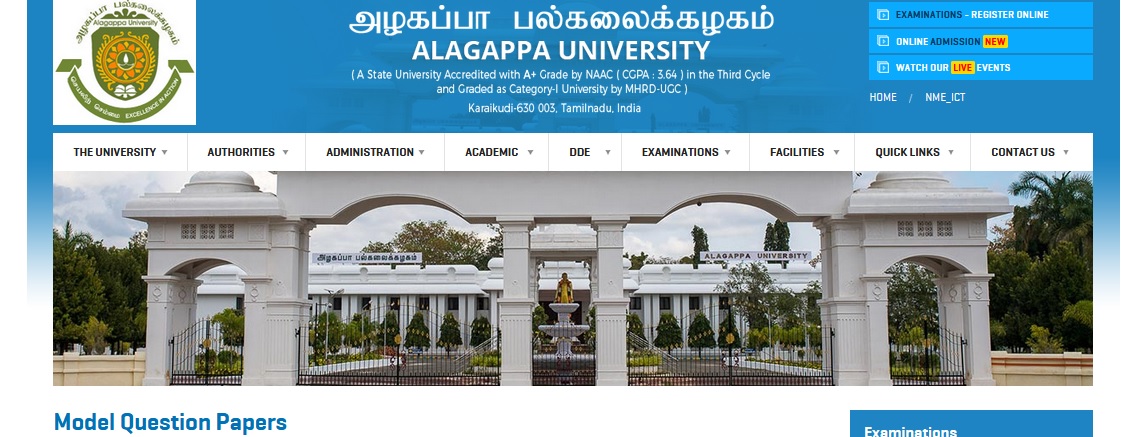General Microbiology And Microbial Taxonomy B.Sc Model Question Papers : alagappauniversity.ac.in
Name of the University : Alagappa University
Degree : B.Sc
Department : Microbiology
Subject Code/Name : General Microbiology And Microbial Taxonomy
Semester : I
Document Type : Model Question Papers
Website : alagappauniversity.ac.in
Download Model/Sample Question Paper : Nov 2010 : https://www.pdfquestion.in/uploads/alagappauniversity.ac.in/3984-B.Sc.MICROBIOLOGY%20CBCS.pdf
Alagappa University General Microbiology Questions
Time : 3 Hours Maximum : 75 Marks
Part A :
Related : Alagappa University Microbiology and Clinical Lab Technology B.Sc Model Question Papers : www.pdfquestion.in/3937.html
1. Contribution of Alexander Fleming.
2. Objective Lense.
3. Pili.
4. Laminar air flow.
5. Lag phase.
6. Kingdom.
7. Phycology.
8. Stigma.
9. Parasite.
10. Virion.

Part B : (5 × 5 = 25)
Answer all the questions. (Choose either (a) or (b))
11. (a) What is spontaneous generation ?
(Or)
(b) Analyse the Koch postulates.
12. (a) Briefly explain the Fluid mosaic model of plasma membrane.
(Or)
(b) Write the structure and functions of Flagella.
13. (a) Briefly define the aerobic culture technique.
(Or)
(b) Define media. Write its components.
14. (a) What are the principles of Taxonomy ?
(Or)
(b) Critically comment on species concept.
15. (a) Briefly explain the Bergey’s manual of bacterial classification.
(Or)
(b) State the structure of plant virus.
Part C : (3 × 10 = 30)
Answer any three questions.
16. Elaborate the principle and components of phase contrast microscope.
17. With suitable diagram explain the structure and functions of bacterial cell wall.
18. What are the factors affecting growth curve ? Explain .
19. Give an overview of biochemical taxonomy.
20. Describe the ultra structure of algal cell.
Microbial Metabolism & Microbial Genetics
(CBCS—2008 onwards)
Time : 3 Hours
Maximum : 75 Marks
Part A (10 × 2 = 20)
Answer all the questions.
1. Lysogeny.
2. F factor.
3. ATP.
4. Ferredoxin.
5. Transamination.
6. Genome.
7. Point mutation.
8. Transcription.
9. Physical Mutagen.
10. Sulfur containing amino acid.
Part B : (5 × 5 = 25)
Answer all questions. (Choose either a or b)
11. (a) Mention the oxidative and substrate level phosphorylation.
(Or)
(b) Calculate the ATP yield from the aerobic oxidation of glucose by eukaryotic cell.
12. (a) What is meant by methanogens ?
(Or)
(b) Comment on aerobic respiration.
13. (a) Write down the reactions of degradation of amino acids.
(Or)
(b) What is Nitrogen Fixation ? Explain.
14. (a) Define mutation. What is chemical mutagen ?
(Or)
(b) Describe how transformation occurs in S. Pneumoniae.
15. (a) Explain the structure of Transposon.
(Or)
(b) Give the major distinguishing features of a plasmid.
Part C : (3 × 10 = 30)
Answer any three questions from the following.
16. Briefly explain the Kreb’s cycle with schematic diagram.
17. Give a detailed account on bacterial photosynthesis.
18. Describe the biosynthesis of nucleic acids.
19. Write short note on :
(i) Excision repair and
(ii) Post replication repair.
20. Describe how Lac operon is regulated .
Environmental & Agricultural Microbiology
(CBCS—2008 onwards)
Time : 3 Hours
Maximum : 75 Marks
Section A (10 × 2 = 20)
Answer all questions.
1. What is mutualism ?
2. Comment on Phyllophere.
3. What is xenobiotics ?
4. Elucidate bioleaching.
5. What is COD ?
6. Bring out the significance of Coliforms.
7. What is virioids ?
8. Comment on Spiroplasma.
9. What is insecticide ?
10. Comment on cry Protein.
Section B : (5 × 5 = 25)
Answer all questions.
11. (a) Give an account on microflora of various soil types.
(Or)
(b) Explain in detail about biofertilizers.
12. (a) Discuss about role of Microbes in carbon cycle.
(Or)
(b) Give a short note on Biomagnification.
13. (a) Explain the significance of Biological Oxygen Demand.
(Or)
(b) Give an account on Eutrophication.
14. (a) Discuss about Tobacco Mosaic Virus.
(Or)
(b) Give an account on Xanthomonas.
15. (a) Give a detailed account on Nematicide.
(Or)
(b) Explain in detail about fungicide.
Section C : (3 × 10 = 30)
Answer any three questions.
16. Discuss about endo and ecto mycorrhizae.
17. Write an essay about air borne diseases caused by bacteria.
18. Discuss about water borne diseases and their preventive measures.
19. Write in detail about pathogen establishment and symptoms of Mycoplasma.
20. Discuss in detail about Bacillus thuringiensis.
Food & Dairy Microbiology
(CBCS—2008 onwards)
Time : 3 Hours
Maximum : 75 Marks
Part- A (10 × 2 = 20)
Answer all questions.
Explain/Comment/Define the following.
1. Asepsis
2. Thermal death time
3. Metmyoglobin
4. Low pH in fish
5. Condensed milk
6. Lactobacillus
7. Intoxication
8. Outbreaks
9. Yogurt
10. Jam
Part- B : (5 × 5 = 25)
Answer all questions.
Each answer not to exceed 200 words.
11. (a) Discuss the role of bacteria in food.
(Or)
(b) Highlight the role of food additives in food preservation.
12. (a) Write an account on spoilage of canned meat.
(Or)
(b) Give an account on spoilage of canned food.
13. (a) Give a short note on qual ity testing procedures.
(Or)
(b) Write the procedure of pasteurization.
14. (a) Give a short note on Food borne diseases.
(Or)
(b) How to prevent food borne infections ?